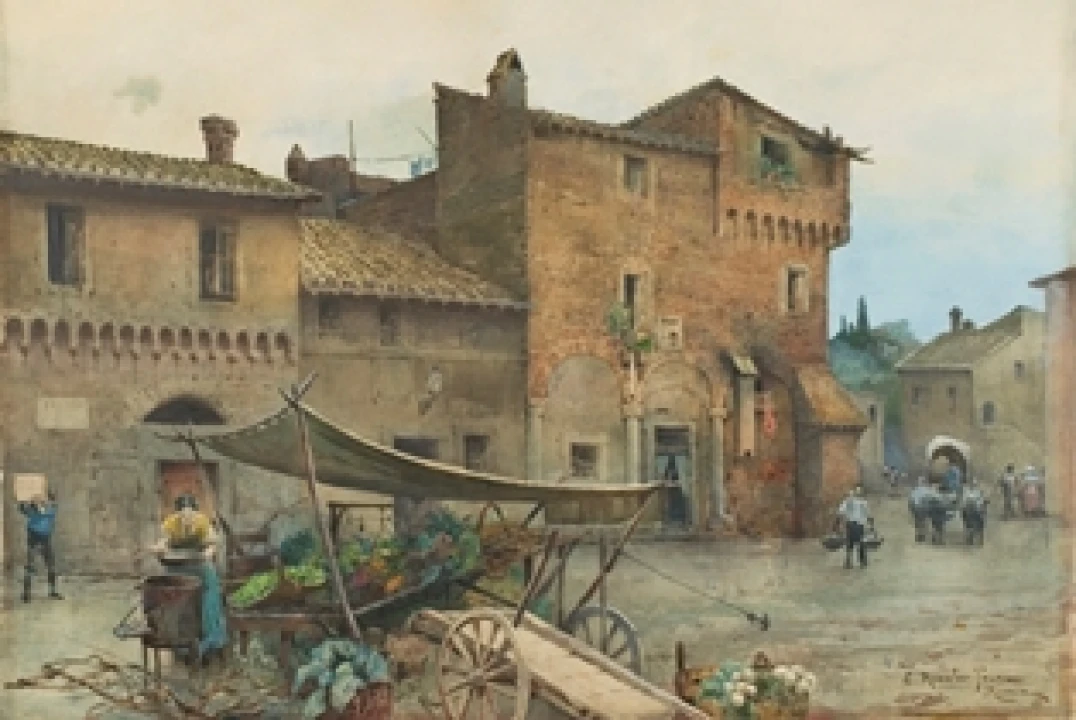by Alessio Garofoli
In Rome, on the banks of the Tiber, around 150 years ago, where Richard Meier's shrine containing the Ara Pacis is located nowadays, there was a small harbor: Porto Di Ripetta, whose appearance, it is said, served as inspiration for Trinità dei Monti Spanish Steps.
At that time the houses next to Tiber's waterfront had often the windows of the lowest floors soaked in the river, and a conical fountain, the Meta Sudans, was still standing before the Arch of Constantine. A past that not even the Romans, or almost none of them, remember today.
But those images can be seen in an extraordinary piece of art: a series of 12 watercolors, by Ettore Roesler Franz, that the painter of German descent - a true Roman though – released between 1878 and 1896, entitled "Roma pittoresca/Memorie di un'era che passa", better known as "Roma Sparita" ("Picturesque Rome/Memories of the passage of an era" or "Vanished Rome").
The paintings depict scenes of everyday life of ordinary people in the historic center of a city that only few years earlier had become the capital of Italy. And what is striking is watching them considering the gigantic urban transformation that followed, triggered by the arrival of the House of Savoy, the Italian royal family, the first expansion of that scale experienced by the city. Until then, Rome had developed more through stratification than tearing down and rebuilding.
The ancient Roman ruins, medieval buildings and churches, the refurbishments of the Renaissance and the Baroque were all part of a continuous overlap and re-use of materials: something that even now does not escape the watchful eye, for example in the Campo de' Fiori area: in via dei Giubbonari or via Capo di Ferro. Or in via del Banco di Santo Spirito, in front of Ponte Sant'Angelo.
The Piedmontese House of Savoy tore down parts of the city to build new avenues and replace narrow streets: Corso Vittorio Emanuele, Corso Rinascimento, Via Arenula, Viale Trastevere. They destroyed the medieval quarter of Piazza Venezia and raised a monument, the Vittoriano, to celebrate the Italian unification. After them only Benito Mussolini would dare so much, demolishing the "Spina di Borgo" area to build via della Conciliazione (in St. Peter's area).
The Royal Family had also raised stone embankments on the Tiber, sparing Romans from frequent floods but erasing centuries of history, including the Porto Di Ripetta harbor, on the other hand. Shortly before all that Roesler Franz, by keeping alive the last remnants of papal Rome, saved its memory: a fascinating city, and indeed picturesque, but also poor and decadent compared to the other western capitals of that time.
Thanks to him we can still see Romans washing clothes in the river, the old Jewish Ghetto fish market in Portico d'Ottavia, the Cestius and Sant'Angelo bridges with their original ancient Roman structure, the seventeenth-century Villa Ludovisi, which will disappear to give birth to the area of the legendary via Veneto. The series of "Vanished Rome" watercolors is on permanent display at the Museo di Roma in Trastevere, in piazza Sant'Egidio.



